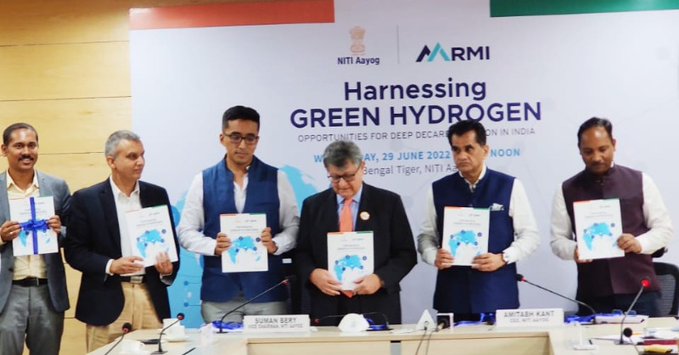India should invest $ 1 billion in green hydrogen R&D, tap export market: NITI Aayog

Photo Credit Twitter @NITIAayog
By Our Special Correspondent
New Delhi, June 29: NITI Aayog on Wednesday unveiled its report on tapping green hydrogen technologies to spur adoption of clean energy while aiming for export market.
The think tank called upon the government to commit USD one billion by 20230 in the research and development for accelerated adoption of green hydrogen as source of energy while also recommending that there should be a green hydrogen corridor within the country for seamless and uninterrupted movement of green hydrogen.
The report of the NITI Aayog has come at a time when the Ministry of Surface Transport had unveiled a hydrogen-powered bus to demonstrate the feasibility of the green hydrogen technology and its wider adoption.
Besides, the US President Joe Biden in an address to the Ministers of environment of scores of countries had spoken for accelerated development and deployment of green hydrogen to eventually replace the European and Indian imports of the Russian oil and gas.
The NITI Aayog’s report ‘Harnessing green hydrogen – Opportunities for decarbonization in India’ laid down policy recommendation for the Centre and the states.
The National Hydrogen Mission was unveiled recently by the Centre.
“A long-term roadmap focused on green hydrogen will improve investors’ confidence and will converge the entire value chain and the various government agencies towards a singular vision,” noted the NITI Aayog.
It stated that “similar to other technology deployment and scaling efforts, government can encourage the cost economics of early producers”.
The current Green Hydrogen policy already focuses on measures like waiver of inter-state transmission (ISTS) charges and granting of open access for green hydrogen and green ammonia production.
“Other measures could include reduction in taxes and surcharges, preferential dollar-based electricity tariff, revenue recycling of any carbon tax, low-emission power purchase agreements (PPAs), and avenues for firming electricity supply including discounted grid electricity to complement variable renewable energy (VRE) generation,” recommended the think-tank panel.
It also called for clear mandates around hydrogen blending in existing (refinery and ammonia) and potentially future consumption sectors (steel and heavy-duty vehicles).
This will provide demand certainty for early green hydrogen projects and encourage market development, said the report.
“For new applications, where the viability of using green hydrogen is still nascent, the government can provide incentives such as a production linked incentive (PLI) scheme for green steel targeting export markets,” added the report.
The roadmap should also identify a timeline and scale of manufacturing support for electrolysers.
“India may aim for 25 GW of electrolysers by 2030, while also investing USD 1 billion in R&D to catalyse the development of commercial green hydrogen technologies across the value chain. Radically improving the speed of regulatory clearances coupled with preferential treatment in public tenders will help catalyse local manufacturing,” noted the report.
The government must explore integrating hydrogen into existing energy and industrial partnerships globally, said the report, adding that this should include developing collective frameworks and creating labelling and standards around green hydrogen and hydrogen-embedded products like green steel and green ammonia.
“The government should explore specific near-term incentives around green ammonia and green steel production,” said the think-tank panel.
The government can provide financial certainty to early adopters through investment facilitation measures like demand aggregation, ensuring availability of long-tenor and low interest finance and initiation of a functioning carbon market, said the report.
It also suggested that the States should be encouraged to launch their own green hydrogen-based policies in order to complement efforts at the national-level.





